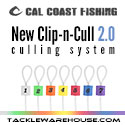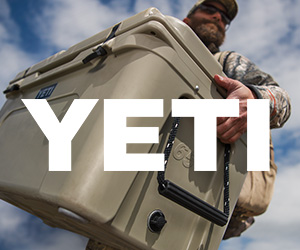TackleTour's 2010 Spinnerbait Shootout!

|
Date: |
5/15/10 |
|
Tackle type: |
Spinnerbaits |
|
Manufacturer: |
Varied |
|
Reviewer: |
Cal |
Introduction: In the spirit of our Search For One themed year, we come to the discussion of baits and perhaps the most nostalgic black bass baits for me are blades. That’s right, not cranks, not big baits, and not jigs, but those little (and sometimes not so little) baits made of bent wire, a jig head, a hook, and some combination of blades. I’m not sure why this is so, but when we’re talking about the essence of bass fishing, what comes to my mind are spinnerbaits.

Perhaps the most nostalgic black bass baits for me are blades.
Earlier this year we headed to Falcon Lake, Texas for some late winter testing of our early entries to our Search For One all purpose rod shootout. As you may have gleamed from our coverage, Falcon is a lake with more than its share of submerged brush - the perfect cover for spinnerbaits. In fact, spinnerbaits are one of the more popular baits to use on this lake so the first thing we did after planning this trip was to load up on a bunch of different brands and styles of blades and toss them into out luggage. Today we present our results, introducing our 2010 Spinnerbait Roundup!

Spinnerbaits are a staple on Falcon Lake, Texas.
When we think of an all purpose rod, one of the baits this type of stick has to handle best is the spinnerbait. There are just so many different ways you can throw and retrieve a bladed bait that it’s just a natural to go along with a multi-purpose rod. Add to this the many different configurations in which bladed baits are now available and making a decision on one or two can be quite difficult. That is why, in our roundup today, we have a total of eight different players.
|
TackleTour's 2010 Spinnerbait Shootout Players |
| |
|
|
|
|
|
Damiki Gladiator |
Wire Tied Silicone |
Double Colorado |
1/4, 3/8 |
Damiki Viper |
$6.99 |
Gann's Stilleto |
Tied Silicone |
Tandem |
1/4, 3/8, 1/2, 3/4, 1, 1 1/2 |
Gamakatsu |
$7.99 |
LC Redemption |
Banded Silicone |
Double Willow and Tandem |
1/4, 3/8, 1/2 |
Gamakatsu |
$13.99 – $14.99 |
McCoy V-Twin |
Tied Silicone |
Twin Willow Leaf |
3/8, 1/2, ¾ |
Gamakatsu |
$8.99 |
Megastrike Strike Back |
Banded Silicone |
tandem |
3/8, 1/2, 3/4 |
Mustad |
$7.95 |
Pepper Hawg |
Banded Silicone |
Double willow |
1/4, 3/8, 1/2, 3/4, 1 |
Gamakatsu |
$5.49 |
Picasso Flip Side |
Banded Silicone |
Double Willow, Single Colorado, Tandem |
1/8, 1/4, 3/8, 1/2, 3/4, |
Not specified |
$5.99 |
Revenge |
Banded Silicone |
Double Willow, Tandem, Single Colorado, Double Colorado |
1/4, 3/8, 1/2, 3/4, 1 1/4 |
Mustad |
$6.99 |
War Eagle Twin Spin |
Banded Silicone |
Twin Colorado |
5/16, 9/16, 3/4 |
Mustad |
$7.29 |
Spinnerbait Basics: Before we get into each individual product, let’s take a step back and look at some of the basics of the spinnerbait as a product. There are so many varieties in our test batch alone, it’s a good idea to see what some of the differences are right off the bat:

If I was forced to fish one bait and one bait only while out on a trip for black bass, believe it or not, my number one choice would be a spinnerbait.
The Blades: There are several different blade types but the three most popular are the willow, Colorado, and Indiana. The key difference between each blade, aside from their obvious shapes, is the amount of water each blade catches and therefore, the amount of disturbance or vibration they create during the retrieve.

Willow leaf blades are great for fast moving presentations and clear water.
The Colorado blade gives off the most vibration and can be retrieved at the slowest speed which makes it a good choice for cold and/or stained water. The willow leaf blade gives off the least amount of vibration but is easier to retrieve at a fast pace which makes it a good choice for warm and/or clear water situations. The Indiana blade is generally regarded as a hybrid between the other two options.

The Colorado blade is good for slow rolling and stained water.
The Skirt: Spinnerbait skirts are almost always silicone.
Silicone is the most responsive in fast moving situations where as living rubber has the ability to pulse and sway with current movement when your bait is stationary (which is why it is so popular with jigs).

Indiana blades are often regarded as a hybrid of the willow and Colorado.
Unlike jigs, where a hand tied skirt is instantly more desirable than one fastened via a thick rubber band, with spinnerbaits, this is not as critical a factor. Remember, part of the reason for seeking out hand tied skirts in a jig is this method of fastening results in a better flare in the skirt when the bait is stationary. Since a spinnerbait is generally fished with constant movement, this factor is not quite as important.

Though not as important as with a jig, some spinnerbaits come with hand tied skirts.
Moreover, for those who like to change skirt colors on the fly rather than switch out their spinnerbaits, the banded products are much easier to take off and re-apply than a hand tied skirt. All that being said, there’s no denying the care and quality that’s conveyed with a hand tied product.

By far the most common method of attaching a skirt to the body of a spinnerbait is with a thick rubber band.
The Head: Though this aspect is changing with the availability of some spinnerbaits with a football head configuration, generally speaking, most spinnerbait heads feature a slim profile, swimming shape profile to them. The reasons are obvious that since these baits are made to be swum through cover, they feature should feature a profile that facilitates this technique.

Head designs vary but the majority feature some kind of streamlined head for better swimming performance in and out of weeds.
Field Tests: There are any number of different ways to fish a spinnerbait and certainly many different combinations of rods, reels, retrieve ratios and fishing line with which to throw them. What we had on hand during our trip to Falcon Lake, Texas were not only a collection of our Search For One rod shootout entries, but also a variety of reels. One constant was our selection of braid, generally Daiwa Samurai Braid or Suffix Performance Braid, and the use of a fluorocarbon leader (generally 20lb Seaguar Tatsu). This combination of a superline mainline with a fluorocarbon leader is almost a prerequisite when fishing the brush infested waters of Falcon Lake, Texas.
Next
Section: Damiki and Gann's Performance Tackle ... 




























